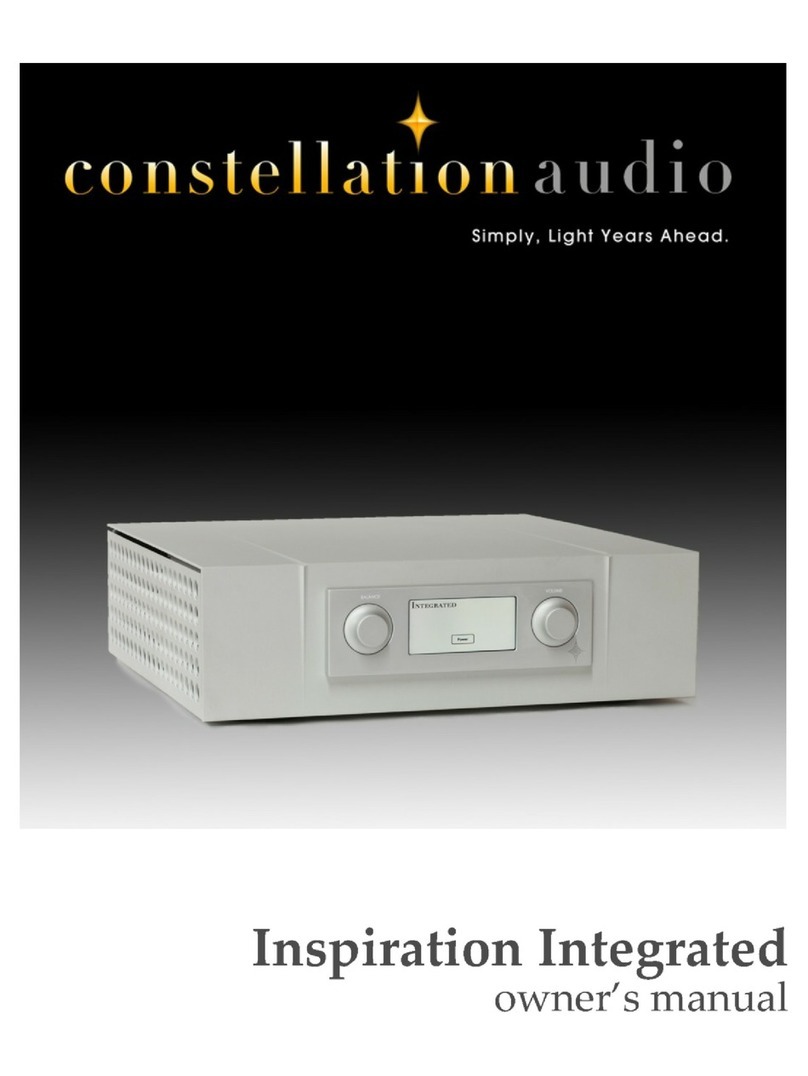
Operation
Initial installation and power-up
STEP 1: Before making any connections, make sure the amplifier’s master power switch is turned off. If the
AC has not been connected, connect the amplifier(s) to the wall AC power socket using the supplied cord.
STEP 2: If you are using Hercules II Monos, connect a high-quality speaker cable from the left speaker to the
left amplifier’s binding posts, and repeat the process for the right speaker/channel. If you are using a
Hercules II Stereo amp, connect the speaker cable from the left channel binding posts to the left speaker,
and repeat for the right channel/speaker. Be sure to connect the marked (often red) connector or cable to
the positive (red or +) binding post on the amplifier, and the unmarked (often black) connector or cable to the
negative (black or -) binding post on the amplifier. If you are using Hercules II Monos, you may use either of
the two positive (red or +) posts and either of the two negative (black or -) posts; just make sure that the
red/+ post is connected to the red/+ cable and that the black/- post is connected to the black/- cable.
Repeat for the right speaker.
If you are biwiring/biamping your speakers using the Hercules II Stereo amp, set the Biwire switch to on,
connect one channel of the Hercules II Stereo to the speaker’s lower pair of binding posts, and the other
channel to the speakers upper pair of binding posts.
Make sure that the conductors of the cables do not touch; that there are no stray wires coming from the
cables that might cause a short circuit; and that the amplifier and speakers do not come into contact with
metal objects that might cause a short circuit. While the amplifier is internally protected against short
circuits, it delivers enough current to vaporize small wires, so a fire hazard can result in the event of a short
circuit.
STEP 3: Connect a high-quality XLR balanced audio interconnect from the left channel of the preamp output
to the left Hercules II Mono’s XLR input or the Hercules II Stereo’s left channel XLR input. Use the Direct input
if you are using a Constellation Audio Virgo or Altair preamp; the BAL input if you are using a balanced XLR
connection from a different brand of preamp, and the RCA input if your preamp offers only unbalanced RCA
output. Repeat for the right channel.
If you are biwiring/biamping your speakers using a pair of Hercules II Stereo amps, connect the signal from
the left-channel output of the preamp to the right-channel (lower) input of the left Hercules II Stereo, and the
right-channel preamp output to the right-channel (lower) input of the right Hercules II Stereo.
STEP 4: Using the input select switch near the amplifier’s input jacks on the back panel, select the input to
which you connected the interconnect cables. Set the switch to BAL (left position) if using the regular
balanced inputs, Direct (middle position) if using the Constellation Direct Direct inputs, or RCA if using the
unbalanced RCA inputs.
STEP 5: Make sure the mute switch is set to Off (on both amps if you are using Hercules II Monos or two
Hercules II Stereo amps.
STEP 6: Turn on the master power switch on the back of the amplifier (both amps if you are using Hercules II
Mono or biwiring with Hercules II Stereos), above the connection for the AC cord. The front LED status
indicator on the amplifier(s) should glow red. If it does not, check your AC connection.
STEP 7: To power up the amp, push the left side of the bar on the front panel for 3 seconds. The LED status
indicator in the middle of the bar will start flashing green, which indicates that the amplifier is warming up.
After 1 minute the indicator will turn solid blue and the amp will be active. If the preamp and a source are
connected and playing, and the volume on the preamp is up, you should hear sound.

































